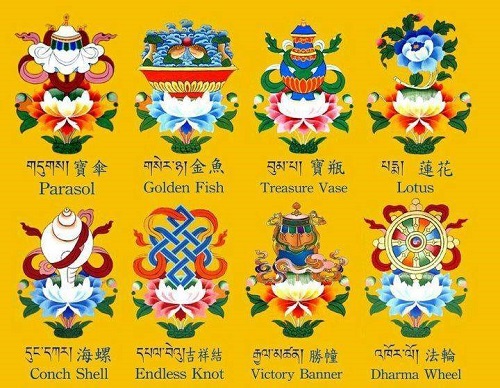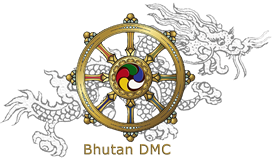Tashi Tagye / Eight Auspicious Signs
This set of symbols are very popular in Bhutan and you can find them in dzongs, temples, monasteries, home and offices. It is also known in Sanskrit as ‘Ashtamangala’, ashta means eight and mangala means auspicious and they carry special meanings.
The Dug (Parasol) ; embodies notion of wealth or royalty. It also symbolizes protection from harm like illness, harmful forces, obstacles and so forth, and the enjoyment of shade under it.
The Ernya (Golden Fish) ; were originally symbolic of the river Ganges and Yamuna but came to represent good fortune in general for Hindus, Jain and Buddhists. In Buddhism, it also symbolizes that living beings who practice ‘dharma’ have no fear to drown in ocean of suffering and can freely migrate like fish in water.
The Bumpa (Treasure Vase) ; is a sign of the inexhaustible riches available in the Buddhist teachings, but also symbolizes long life, wealth, prosperity and all the benefits of the world.
The Meto Pema (Lotus) ; an important symbol in India and of Buddhism, it refers to complete purification of body, speech and mind and the blossoming of wholesome deeds in liberation. The lotus refers to many aspects of the path, as it grows from the mud, which is representation of endless cycle of suffering, up through clean water (purification), and arising from the deep produces beautiful flower (enlightenment). The white blossom represents the purity, the stem stands for the practice of Buddhist teachings which raise the mind above the (mud of) worldly existence and give rise to purity of mind. An open blossom signifies the potential for enlightenment.
The Dungkar (Conch Shell) ; which is also used as a horn and symbolizes the deep, far reaching and melodious sound of the teachings. It also symbolizes reverberating sound of Dharma and signifies the awakening of sentient beings from the sleeping state of ignorance. It persuades them towards the path of noble deeds that are beneficial for others.
The Palbheu (Endless Knot) ; symbolizes the nature of reality where everything is interrelated and only exits as part of a web of karma and its effect. Having no beginning or end, it also represents that infinite wisdom of Buddha and the union of compassion and wisdom. Also, it represents the illusory character of time and long life as it is endless.
The Gyeltshen (Victory Banner) ; symbolizes the victory of Buddha’s teachings over death, ignorance, disharmony and all the negatives of this world, and victory over. This symbol also signifies the fortune of having victory of good over the evil forces which hinders the success of noble goals and also proclaims the victory of deity over evil.
The Khorlo (Dharma Wheel) ; it is said that after Buddha achieved enlightenment, the Hindu God Brahma came to him, offered a Dharma-wheel and requested Buddha tto teach the truth to all sentient beings. So, it represents the Buddhist teachings.
HOTELS IN THIMPHU
HOTELS IN PUNAKHA & WANGDUE
HOTELS IN GANGTEY
HOTELS IN TRONGSA
HOTELS IN BUMTHANG
HOTELS IN MONGAR
HOTELS IN TRASHIGANG
HOTELS IN SAMDRUP JONGKHAR
HOTELS IN PHUENTSHOLING
HOTELS IN HAA
HOTELS IN GELEPHU
HOTELS IN ZHEMGANG
RESTAURANTS IN PARO
RESTAURANTS IN THIMPHU
RESTAURANTS IN PUNAKHA
TOUR ITINERARIES
TREKKING ITINERARIES
SPECIAL INTERESTS TOURS
UNIQUE FESTIVALS & FAIRS
BLOG


